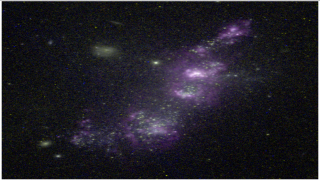Bibcode
González-Martín, Omaira; Masegosa, Josefa; García-Bernete, Ismael; Ramos Almeida, Cristina; Rodríguez-Espinosa, José Miguel; Márquez, Isabel; Esparza-Arredondo, Donaji; Osorio-Clavijo, Natalia; Martínez-Paredes, Mariela; Victoria-Ceballos, César; Pasetto, Alice; Dultzin, Deborah
Referencia bibliográfica
The Astrophysical Journal
Fecha de publicación:
10
2019
Revista
Número de citas
38
Número de citas referidas
35
Descripción
This is the second in a series of papers devoted to exploring a set of six dusty models of active galactic nuclei (AGN) with available spectral energy distributions. These models are the smooth torus by Fritz et al., the clumpy torus by Nenkova et al., the clumpy torus by Hönig & Kishimoto, the two-phase torus by Siebenmorgen et al., the two-phase torus by Stalevski et al., and the wind model by Hönig & Kishimoto. The first paper explores discrimination among models and the parameter restriction using synthetic spectra. Here we perform spectral fitting of a sample of 110 AGN drawn from the Swift/BAT survey with Spitzer/IRS spectroscopic data. The aim is to explore which is the model that describes better the data and the resulting parameters. The clumpy wind-disk model by Hönig & Kishimoto provides good fits for ̃50% of the sample, and the clumpy torus model by Nenkova et al. is good at describing ̃30% of the objects. The wind-disk model by Hönig & Kishimoto is better for reproducing the mid-infrared spectra of type 1 Seyferts (with 60% of the type 1 Seyferts well reproduced by this model compared to the 10% well represented by the clumpy torus model by Nenkova et al.), while type 2 Seyferts are equally fitted by both models (roughly 40% of the type 2 Seyferts). Large residuals are found irrespective of the model used, indicating that the AGN dust continuum emission is more complex than predicted by the models or that the parameter space is not well sampled. We found that all the resulting parameters for our AGN sample are roughly constrained to 10%-20% of the parameter space. Contrary to what is generally assumed, the derived outer radius of the torus is smaller (reaching up to a factor of ̃5 smaller for 10 pc tori) for the smooth torus by Fritz et al. and the two-phase torus by Stalevski et al. than the one derived from the clumpy torus by Nenkova et al. Covering factors and line-of-sight viewing angles strongly depend on the model used. The total dust mass is the most robust derived quantity, giving equivalent results for four of these models.
Proyectos relacionados

Grupo de Estudios de Formación Estelar GEFE
El proyecto interno GEFE está enmarcado en el proyecto coordinado, ESTALLIDOS, financiado por el plan nacional desde el año 2001. El ultimo proyecto aprobado es ESTALLIDOS 6.0 (AYA2016- 79724-C4-2-P). En el proyecto GEFE trabajamos en base al caso científico del proyecto ESTALLIDOS 6.0. Los estallidos de formación estelar (Starbursts o SB) son
Casiana
Muñoz Tuñón
![Teacup en [O III] y CO(2-1) Los agujeros negros supermasivos modifican la distribución de gas molecular en la región central de las galaxias. Crédito: HST y C. Ramos Almeida.](/sites/default/files/styles/crop_square_2_2_to_320px/public/images/project/teacup_english.001.jpeg?itok=dF4bDw-q)
Actividad Nuclear en Galaxias: una Perspectiva 3D del Núcleo y su Entorno
Nuestro proyecto puede dividirse en dos líneas principales de investigación. En primer lugar, el estudio de los vientos producidos por cuásares luminosos oscurecidos y del impacto que estos tienen en sus galaxias anfitrionas (retroalimentación del AGN). Para ello hemos obtenido observaciones infrarrojas y ópticas con los instrumentos del Gran
Cristina
Ramos Almeida